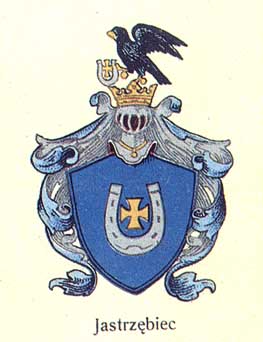


One branch of the Sypniewski family, Marcin Sypniewski, renamed himself Dzierzgowski and took the coat of arms of Jastrzebiec in 1270, during the reign of King Przemysl~ II (1257-1296), a Piast. After taking control of Wielkopolska and eastern Pomerania, King Prezemysl~ crowned himself King of Gniezno, in 1295. This act resulted in the King falling victim to cut-throats hired by the Brandenburgs in 1296.
It it thought that a Galician branch called Jerewskich is an earlier ancestor of theis line.
Sir Jacob Runge-Sypniewski eventually dropped the Runge and was known as Sypniewski. The Runge family received their nobilty ranking in 1550 in Greater Poland and Lithuania. Jacob's holdings were Sypniewo, and he became a member of the
Odrowaz clan (Prussia 1490). Both branches of this family then settled in Poznan, Poland, after moving from their original home in Germany.
The properties discussed here will be:
Both estates were located roughly in the 53o N Latitude, and 17oE. Longitude. The Runge-Sypniewski estates are in the voivodship of Wielkopolski (Greater Poland); the district Pilski, The Borough L~obzeniza diaconate (after 1617). From 1821-1920, when this part of Poland was under German control, the Lobzenica diaconate was part of the Bydgoszcz diaconate. The present postal code is 89-312.
Parishes in this vicinity were Lodzenica, Luchowo, Sypniewo, Runowo, and Dedno.
The Dzwierszno estates were located south of Sypniewo (54 N, 17E), which was in Wielkopolski: Kujawski-Pomerse. Postal code 89-422 (Sypniewo).
The properties of the Dzierzgowski family (originaly Runge-Sypniewski) were located in the town of Dzwierszno. Dzwierszno was a hilly area near Lake Stryjewo, in Gniezno Province (now Poznan, Poland). Another lake in Wyrzysk County is named Dzewianowo.
A Catholic Church Parish was established here in the 13th and 14th centuries. Monasteries and churches were the first stone buildings in Poland. Several were built in the 11th century by the Benedictines and later the Cisterians. This was most likely a Cisterian group since the Cisterians received a donation of land. in 1225, near Zlotow, Lobenica, and Weicbork. Monasteries were the schools and hospitals of their day. The first recorded record of activities, in Dzwierszno, were in the year 1389. This refers to the owners of Dzwierszno as Janko and Andrzej. There is mention of this town in 1416 and in 1426 when the pastor was listed as Rev. Jakub. By 1511, records mention both Welkie and Mal~e. By the end of the 15th century, this area is a city. Until 1512, Dzwierszno was in the Naklo diaconate and the Gniezno diocese.
By 1580, an inn was attached to Wielkie. These two estates were originally owned by Sir Jacob Rungi (also
known as Sir Jacob Runge-Sypniewski). By 1576, the hyphenated surname was made to just "Sypniewski," after their manor houses (called Sypniewo) to the north of these properties (see above). The Sypniewskis were knights, thus the "Sir."
When Tytus Dzial~ynski (1796-1861) owned both Kornik and Dzwierszno, he had Kornik reconstructed by a Berlin Architect called Karl Friedrich Schinkel. After his death, in 1861, Wladyslaw Zamoyski continued Dzialynski's work. In 1925 Zamoyski founded the Kornik Foundation. Today, the castle is a museum (Bujak, 50).
The Dzial~ynski Family:
Tytus Dzial~ynski was born December 24, 1796 in Poznan, Poland; and died April 11, 1861(Tamze).
Jan Dzil~ynski was born on September 28, 1829,in Kornik, Poznan, Poland; and died on March 30, 1880, in Taze.
In 1711 there was a plague in Dzwierszno and the aftermath was the funeral pyre of dead bodies. No one was buried in the traditional way during the plague, because they wanted to assure that the germs did not spread. Fires were often started in the streets where the dead fell, and it is thought that one of these fires might have spread to the surrounding buildings thus destroying many documents contained in the Archdiocese in Cerekwica Chancellery.
In an effort to replace the destroyed dumentation,
"Adam Tytus Dzialynski founded the Poznan Society of Friends of Learning which began publishing manuscript sources in the 1840's and his library and collections also became a public institution. The library contained everything from old coins to folk songs. These items were all documented and publications such as Samuel Bogumil Linde's Great Polish Dictionary" (1814) (Zamoyski).
On January 4, 1793, a Treaty of Partition gave Prussia: Danzig, Thorn, and all of Wielkopolska (Greater Poland).
Families that owned this house after the Runge-Sypniewskis were:
Debno Palace was also located in the Dzwierszno Parish
SOURCES:
Brezinski(editor and translator), Richard. An Illustrated History of Poland. Poznan, Poland: Podsieldlik-Raqniowski & Co., Ltd., 1998.
Bujak, Adam. Castles and Fortresses in Poland. Bellona, 50.
Dziegielewski, Jan and others. Encyklopedia Historii Polski. Warsaw: Morex s.c. - Egross, 1994, 158-159.
Rybacku, Rev. Kajetan. Polish Genealogical Society of America Publication, Winter Bulletin - 1986.
Slownik Geograficzny Krolestwa Polskiego. Warsaw, 1895, Volume 14.
Zamoyski, Adam. The Polish Way. New York: Hippocrene Books, Inc., 1996, 268.

© 1997 E-Mail:Vondoering@aol.com
